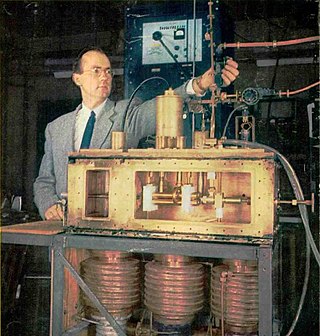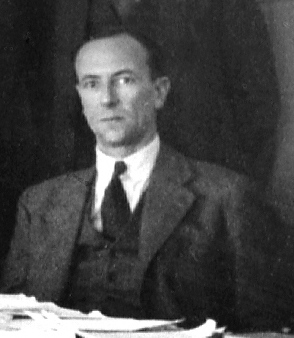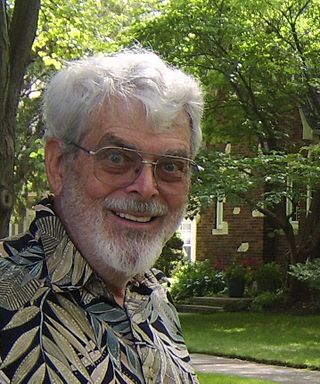Related Research Articles

A laser is a device that emits light through a process of optical amplification based on the stimulated emission of electromagnetic radiation. The word laser is an anacronym that originated as an acronym for light amplification by stimulated emission of radiation. The first laser was built in 1960 by Theodore Maiman at Hughes Research Laboratories, based on theoretical work by Charles H. Townes and Arthur Leonard Schawlow.

A maser is a device that produces coherent electromagnetic waves (microwaves), through amplification by stimulated emission. The term is an acronym for microwave amplification by stimulated emission of radiation. The first maser was built by Charles H. Townes, James P. Gordon, and Herbert J. Zeiger at Columbia University in 1953. Townes, Nikolay Basov and Alexander Prokhorov were awarded the 1964 Nobel Prize in Physics for theoretical work leading to the maser. Masers are also used as the timekeeping device in atomic clocks, and as extremely low-noise microwave amplifiers in radio telescopes and deep-space spacecraft communication ground stations.

The neutron is a subatomic particle, symbol
n
or
n0
, which has a neutral charge, and a mass slightly greater than that of a proton. Protons and neutrons constitute the nuclei of atoms. Since protons and neutrons behave similarly within the nucleus, and each has a mass of approximately one dalton, they are both referred to as nucleons. Their properties and interactions are described by nuclear physics. Protons and neutrons are not elementary particles; each is composed of three quarks.

Nuclear physics is the field of physics that studies atomic nuclei and their constituents and interactions, in addition to the study of other forms of nuclear matter.

Spectroscopy is the field of study that measures and interprets the electromagnetic spectra that result from the interaction between electromagnetic radiation and matter as a function of the wavelength or frequency of the radiation. In simpler terms, spectroscopy is the precise study of color as generalized from visible light to all bands of the electromagnetic spectrum.
The Mössbauer effect, or recoilless nuclear resonance fluorescence, is a physical phenomenon discovered by Rudolf Mössbauer in 1958. It involves the resonant and recoil-free emission and absorption of gamma radiation by atomic nuclei bound in a solid. Its main application is in Mössbauer spectroscopy.

A nuclear isomer is a metastable state of an atomic nucleus, in which one or more nucleons (protons or neutrons) occupy excited state (higher energy) levels. "Metastable" describes nuclei whose excited states have half-lives 100 to 1000 times longer than the half-lives of the excited nuclear states that decay with a "prompt" half life (ordinarily on the order of 10−12 seconds). The term "metastable" is usually restricted to isomers with half-lives of 10−9 seconds or longer. Some references recommend 5 × 10−9 seconds to distinguish the metastable half life from the normal "prompt" gamma-emission half-life. Occasionally the half-lives are far longer than this and can last minutes, hours, or years. For example, the 180m
73Ta
nuclear isomer survives so long (at least 1015 years) that it has never been observed to decay spontaneously. The half-life of a nuclear isomer can even exceed that of the ground state of the same nuclide, as shown by 180m
73Ta
as well as 192m2
77Ir
, 210m
83Bi
, 242m
95Am
and multiple holmium isomers.
Thorium (90Th) has seven naturally occurring isotopes but none are stable. One isotope, 232Th, is relatively stable, with a half-life of 1.405×1010 years, considerably longer than the age of the Earth, and even slightly longer than the generally accepted age of the universe. This isotope makes up nearly all natural thorium, so thorium was considered to be mononuclidic. However, in 2013, IUPAC reclassified thorium as binuclidic, due to large amounts of 230Th in deep seawater. Thorium has a characteristic terrestrial isotopic composition and thus a standard atomic weight can be given.
Natural tantalum (73Ta) consists of two stable isotopes: 181Ta (99.988%) and 180m
Ta
(0.012%).

Laser pumping is the act of energy transfer from an external source into the gain medium of a laser. The energy is absorbed in the medium, producing excited states in its atoms. When for a period of time the number of particles in one excited state exceeds the number of particles in the ground state or a less-excited state, population inversion is achieved. In this condition, the mechanism of stimulated emission can take place and the medium can act as a laser or an optical amplifier. The pump power must be higher than the lasing threshold of the laser.

Mössbauer spectroscopy is a spectroscopic technique based on the Mössbauer effect. This effect, discovered by Rudolf Mössbauer in 1958, consists of the nearly recoil-free emission and absorption of nuclear gamma rays in solids. The consequent nuclear spectroscopy method is exquisitely sensitive to small changes in the chemical environment of certain nuclei.
The hafnium controversy was a debate over the possibility of 'triggering' rapid energy releases, via gamma ray emission, from a nuclear isomer of hafnium, 178m2Hf. Per event the energy release is 5 orders of magnitude more energetic than in a typical chemical reaction, but 2 orders of magnitude less than a nuclear fission reaction. In 1998, a group led by Carl Collins of the University of Texas at Dallas reported having successfully initiated such a trigger. Signal-to-noise ratios were small in those first experiments, and to date no other group has been able to duplicate these results. Peter Zimmerman described claims of weaponization potential as having been based on "very bad science".

A nuclear clock or nuclear optical clock is a notional clock that would use the frequency of a nuclear transition as its reference frequency, in the same manner as an atomic clock uses the frequency of an electronic transition in an atom's shell. Such a clock is expected to be more accurate than the best current atomic clocks by a factor of about 10, with an achievable accuracy approaching the 10−19 level. The only nuclear state suitable for the development of a nuclear clock using existing technology is thorium-229m, a nuclear isomer of thorium-229 and the lowest-energy nuclear isomer known. With an energy of about 8 eV, the corresponding ground-state transition is expected to be in the vacuum ultraviolet wavelength region around 150 nm, which would make it accessible to laser excitation. A comprehensive review can be found in reference.
In atomic physics, giant resonance is a high-frequency collective excitation of atomic nuclei, as a property of many-body quantum systems. In the macroscopic interpretation of such an excitation in terms of an oscillation, the most prominent giant resonance is a collective oscillation of all protons against all neutrons in a nucleus.

A gamma ray, also known as gamma radiation (symbol γ or ), is a penetrating form of electromagnetic radiation arising from the radioactive decay of atomic nuclei. It consists of the shortest wavelength electromagnetic waves, typically shorter than those of X-rays. With frequencies above 30 exahertz (3×1019 Hz), it imparts the highest photon energy. Paul Villard, a French chemist and physicist, discovered gamma radiation in 1900 while studying radiation emitted by radium. In 1903, Ernest Rutherford named this radiation gamma rays based on their relatively strong penetration of matter; in 1900 he had already named two less penetrating types of decay radiation (discovered by Henri Becquerel) alpha rays and beta rays in ascending order of penetrating power.
The isomeric shift is the shift on atomic spectral lines and gamma spectral lines, which occurs as a consequence of replacement of one nuclear isomer by another. It is usually called isomeric shift on atomic spectral lines and Mössbauer isomeric shift respectively. If the spectra also have hyperfine structure the shift refers to the center of gravity of the spectra. The isomeric shift provides important information about the nuclear structure and the physical, chemical or biological environment of atoms. More recently the effect has also been proposed as a tool in the search for the time variation of fundamental constants of nature.

The discovery of the neutron and its properties was central to the extraordinary developments in atomic physics in the first half of the 20th century. Early in the century, Ernest Rutherford developed a crude model of the atom, based on the gold foil experiment of Hans Geiger and Ernest Marsden. In this model, atoms had their mass and positive electric charge concentrated in a very small nucleus. By 1920, isotopes of chemical elements had been discovered, the atomic masses had been determined to be (approximately) integer multiples of the mass of the hydrogen atom, and the atomic number had been identified as the charge on the nucleus. Throughout the 1920s, the nucleus was viewed as composed of combinations of protons and electrons, the two elementary particles known at the time, but that model presented several experimental and theoretical contradictions.

Johndale C. Solem is an American theoretical physicist and Fellow of Los Alamos National Laboratory. Solem has authored or co-authored over 185 technical papers in many different scientific fields. He is known for his work on avoiding comet or asteroid collisions with Earth and on interstellar spacecraft propulsion.
George Curriden Baldwin was an American theoretical and experimental physicist. He was a professor of nuclear engineering at Rensselaer Polytechnic Institute and a scientist working at the General Electric Research Laboratory and at the Los Alamos National Laboratory. He wrote a book on Nonlinear Optics and authored or co-authored over 130 technical papers.
A gravity laser, also sometimes referred to as a Gaser, Graser, or Glaser, is a hypothetical device for stimulated emission of coherent gravitational radiation or gravitons, much in the same way that a standard laser produces coherent electromagnetic radiation.
References
- ↑ Baldwin, G. C. (1979). "Bibliography of GRASER research". Los Alamos Scientific Laboratory Report LA-7783-MS. doi:10.2172/6165356. OSTI 6165356.
- ↑ Pittalwala, Iqbal (2019-12-05). "Gamma-ray laser moves a step closer to reality". University of California, Riverside. Retrieved 2022-11-27.
- ↑ Ginzburg, V. L. (2003). "On superconductivity and superfluidity". The Nobel Prize in Physics 2003: 96–127.
- ↑ Baldwin, G. C.; Solem, J. C.; Gol'danskii, V. I. (1981). "Approaches to the development of gamma-ray lasers". Reviews of Modern Physics. 53 (4): 687–744. Bibcode:1981RvMP...53..687B. doi:10.1103/revmodphys.53.687.
- ↑ Baldwin, G. C.; Solem, J. C. (1979). "On the direct pumping of gamma-ray lasers by neutron capture". Nuclear Science & Engineering. 72 (3): 290–292. doi:10.13182/NSE79-A20385.
- ↑ Vali, V.; Vali, W. (1963). "Induced gamma y-ray emission". Proceedings of the IEEE. 51 (1): 182–184. doi:10.1109/proc.1963.1677.
- ↑ Letokhov, V. S. (1973). "On the problem of the nuclear-transition gamma-laser". Journal of Experimental and Theoretical Physics. 37 (5): 787–793. Archived from the original on 2016-03-11. Retrieved 2016-02-24.
- ↑ Kamenov, P.; Bonchev, T. (1975). "On the possibility of realizing a gamma laser with long-living isomer nuclei". Bolgarskaia Akademiia Nauk, Doklady. 28 (9): 1175–1177. Bibcode:1975BlDok..28.1175K.
- ↑ Il'inskii, Yu. A.; Khokhlov, R. V. (1976). "Possibility of creating a gamma-laser". Radiophysics and Quantum Electronics. 19 (6): 561–567. Bibcode:1976R&QE...19..561I. doi:10.1007/bf01043541. S2CID 120340405.
- ↑ Baldwin, G. C. (1977). "On the Feasibility of Grasers". Laser Interaction and Related Plasma Phenomena. Vol. 4A. pp. 249–257. doi:10.1007/978-1-4684-8103-7_13. ISBN 978-1-4684-8105-1.
- ↑ Andreev, A. V.; Il'inskii, Yu. A.; Khokhlov, R. V. (1977). "Role of collective and induced processes in the generation of Mössbauer gamma radiation". Journal of Experimental and Theoretical Physics. 46 (4): 682–684. Bibcode:1977JETP...46..682A. Archived from the original on 2016-03-11. Retrieved 2016-02-24.
- ↑ Hien, P. Z. (1970). "Spontaneous emission of gamma quanta by a system containing identical nuclei". Journal of Experimental and Theoretical Physics. 31 (1): 83–86. Bibcode:1970JETP...31...83Z. Archived from the original on 2016-03-11. Retrieved 2016-02-24.
- ↑ Gol'danskii, V. I.; Kagan, Yu. M. (1973). "Feasibility of the nuclear-transition gamma laser (Graser)". Soviet Physics Uspekhi. 16 (4): 563–565. doi:10.1070/pu1974v016n04abeh005305.
- ↑ Namiot, V. A. (1973). "Stimulated line narrowing and the Mössbauer effect for long-lived isomers". JETP Letters. 18 (6): 369–373. Archived from the original on 2019-02-07. Retrieved 2016-02-24.
- ↑ Andreev, A. V.; Il'inskii, Yu. A.; Khokhlov, R. V. (1974). "Narrowing of gamma resonance lines in crystals by continuous radio-frequency fields". Journal of Experimental and Theoretical Physics. 40 (5): 819–820. Bibcode:1975JETP...40..819A. Archived from the original on 2016-09-27. Retrieved 2016-02-24.
- ↑ Baldwin, G. C. (1979). "Time-domain spectroscopy of recoilless gamma rays". Nuclear Instruments and Methods. 159 (2–3): 309–330. Bibcode:1979NucIM.159..309B. doi:10.1016/0029-554x(79)90656-6.
- ↑ Terhune, I. H.; Baldwin, G. C. (1965). "Nuclear superradiance in solids". Physical Review Letters. 14 (15): 589–591. Bibcode:1965PhRvL..14..589T. doi:10.1103/physrevlett.14.589.
- ↑ Baldwin, G. C. (1974). "Is There a High Frequency Limit to Laser Action?". Laser Interaction and Related Plasma Phenomena. Vol. 3B. pp. 875–888. doi:10.1007/978-1-4684-8416-8_23. ISBN 978-1-4684-8418-2.
- ↑ Andreev, A V.; Il'inskii, Yu. A. (1975). "Amplification in a gamma laser when the Bragg condition is satisfied". Journal of Experimental and Theoretical Physics. 41 (3): 403–405. Bibcode:1975JETP...41..403A. Archived from the original on 2016-03-11. Retrieved 2016-02-24.
- ↑ Il'inskii, Yu. A.; Khokhlov, R. V. (1974). "On the possibility of observation of stimulated gamma radiation". Soviet Physics Uspekhi. 16 (4): 565–567. doi:10.1070/pu1974v016n04abeh005306.
- 1 2 Baldwin, G. C.; Solem, J. C. (1997). "Recoilless gamma-ray lasers". Reviews of Modern Physics. 69 (4): 1085–1117. Bibcode:1997RvMP...69.1085B. doi:10.1103/revmodphys.69.1085.
- ↑ Borrmann, G. (1941). "Über Extinktionsdiagramme der Röntgenstrahlen von Quarz". Physikalische Zeitschrift. 42: 157–162.
- ↑ Kagan, Yu. M. (1974). "Use of the anomalous passage effect to obtain stimulated emission of gamma quanta in a crystal". JETP Letters. 20 (1): 11–12. Archived from the original on 2016-09-06. Retrieved 2016-02-24.
- ↑ Andreev, A. V.; Il'inskii, Yu. A. (1976). "Possible use of the Borrmann effect in the gamma laser". Journal of Experimental and Theoretical Physics. 43 (5): 893–896. Bibcode:1976JETP...43..893A. Archived from the original on 2016-03-11. Retrieved 2016-02-24.
- ↑ Baldwin, G. C.; Solem, J. C. (1979). "Maximum density and capture rates of neutrons moderated from a pulsed source". Nuclear Science & Engineering. 72 (3): 281–289. Bibcode:1979NSE....72..281B. doi:10.13182/NSE79-A20384.
- ↑ Baldwin, G. C.; Solem, J. C. (1995). "Kinetics of neutron-burst pumped gamma-ray lasers". Laser Physics. 5 (2): 326–335.
- ↑ Gol'danskii, V. I.; Kagan, Yu.; Namiot, V. A. (1973). "Two-stage pumping of Mössbauer gamma-ray lasers". JETP Letters. 18 (1): 34–35. Archived from the original on 2016-03-06. Retrieved 2016-02-24.
- ↑ Gol'danskii, V. I.; Kagan, Yu. (1973). "The possibility of creating a nuclear gamma laser". Journal of Experimental and Theoretical Physics. 37 (1): 49. Bibcode:1973JETP...37...49G. Archived from the original on 2016-03-11. Retrieved 2016-02-24.
- ↑ Baldwin, G. C.; Solem, J. C. (1980). "Two-stage pumping of three-level Mössbauer gamma-ray lasers". Journal of Applied Physics. 51 (5): 2372–2380. Bibcode:1980JAP....51.2372B. doi:10.1063/1.328007.
- ↑ Baldwin, G. C. (1984). "Multistep Pumping Schemes for Short-Wave Lasers". Laser Interaction and Related Plasma Phenomena. Vol. 6. pp. 107–125. doi:10.1007/978-1-4615-7332-6_8. ISBN 978-1-4615-7334-0.
- ↑ Solem, J. C.; Biedenharn, L. C. (1987). "Primer on coupling collective electronic oscillations to nuclei" (PDF). Los Alamos National Laboratory Report LA-10878. Bibcode:1987pcce.rept.....S.
- ↑ Biedeharn, L. C.; Baldwin, G. C.; Boer, K. (1986). Nuclear excitation by laser driven coherent outer shell electron oscillations. Proceedings of the First International Laser Science Conference, Dallas, TX, November 18–22, 1985. Stwalley, W. C.; Lapp, M.; Eds. Vol. 146. pp. 52–53. Bibcode:1986AIPC..146...52B. doi:10.1063/1.35933.
- ↑ Solem, J. C.; Biedenharn, L. C.; Rinker, G. A. (1987). "Calculation of harmonic radiation from atoms subjected to strong laser fields and the possibility of nuclear excitation". Journal of the Optical Society of America A. 4: P53. Bibcode:1987JOSAA...4...53S.
- ↑ Solem, J. C.; Biedenharn, L. C. (1988). "Laser coupling to nuclei via collective electronic oscillations: A simple heuristic model study". Journal of Quantitative Spectroscopy and Radiative Transfer. 40 (6): 707–712. Bibcode:1988JQSRT..40..707S. doi:10.1016/0022-4073(88)90066-0.
- ↑ Solem, J. C. (1988). "Theorem relating spatial and temporal harmonics for nuclear interlevel transfer driven by collective electronic oscillation". Journal of Quantitative Spectroscopy and Radiative Transfer. 40 (6): 713–715. Bibcode:1988JQSRT..40..713S. doi:10.1016/0022-4073(88)90067-2.